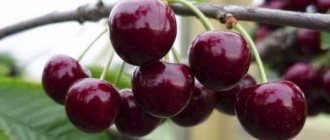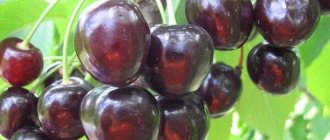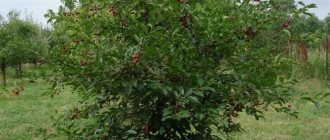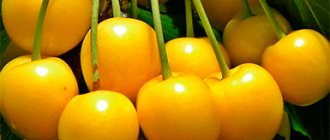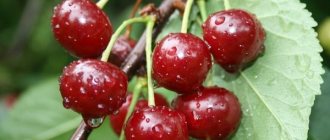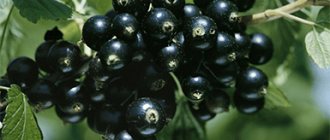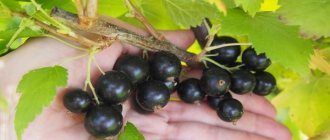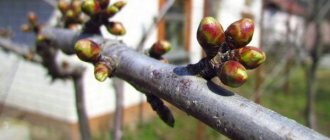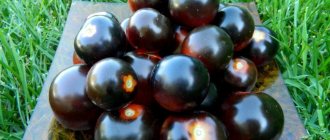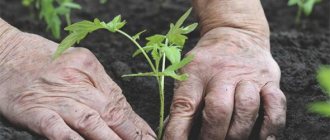Description
Subject to agrotechnical conditions, the tree produces consistently high yields.
The culture is zoned in the Krasnodar Territory, Volgograd, and Astrakhan regions. Growing in the northern regions causes freezing of fruit buds, flowers and ovaries, which reduces the fruiting of Daibera.
general description
Daibera cherry is a mid-season, large-fruited, dessert variety. It has increased requirements for light and soil, moderate requirements for heat and moisture. When shaded, the plant does not take root on clay soils. In cold, rainy springs it is susceptible to viral infection of leaves and fruits.
The tree is powerful, tall, with a rounded, well-leafed, semi-spreading crown. Daibera produces its first fruits at the age of 5 years. To form ovaries, it requires cross-pollination.
Advantages
A positive quality of the Daibera variety is its friendly, stable ripening. The berries are juicy, have a pleasant, sweet and sour taste, are rich in vitamins, and are well stored and transported.
Cherries produce high quality:
- juice;
- puree;
- compote.
Wine and jam are prepared by adding cherries and plums for acidity and aroma. A flowering tree decorates the garden landscape. When grown in regions with suitable climate and soils, Daibera requires minimal care.
Flaws
Daiber's cherry without a pollinator remains sterile and does not form ovaries. Wood, leaves, and fruits are susceptible to pathogenic infection. At temperatures down to -24 degrees, flower buds die. Frost of 30 degrees causes the bark to die: the trunk, branches and shoots freeze. During the ripening period, both drought and heavy rainfall negatively affect the quantity and quality of the crop.
Bud
Fruiting is concentrated on bouquet branches, at the ends of which flowers are collected and a growth bud is formed. Flower buds are round, the growth bud is located in the center of the inflorescences. After the fruits ripen, the flower buds die, and a shoot with 5 internodes and 6 buds is formed from the growth bud.
Leaf and flower
Daibera's crown has good foliage. The leaf is dark green, large, elongated, with a pointed end. The width of the leaf plate is 8 centimeters, length is 15 centimeters. The petiole is long.
The tree produces bisexual white flowers before the leaves appear. There are 2 buds in one inflorescence. A blooming flower is a rosette of 5 corrugated petals, a pistil and stamens. The period from the appearance of buds to the fall of the petals is 2-3 weeks.
Fetus
The fruits of Daibera cherries are large, round, wider at the stalk.
Weight
The berry, on average, weighs up to 6-7 grams.
Height
The height of the fruit is 2.5-2.7 centimeters.
Width
The width of the berry is 2.1 centimeters.
Thickness
The diameter of the fruit is 1.9 centimeters at the stalk.
Color
The color of the berries is burgundy, with a black tint.
peduncle
The stalk is thick, firmly attached to the berry. Length – 4-5 centimeters.
Bone
The stone is easily separated from the pulp, round, small.
general characteristics
Daibera berries are large, dark red, and easily separated from the stalk. The pulp is dense, juicy, red in color, and easily removed from the pit.
Taste qualities
The nutritional benefits of the Daibera variety are determined by:
- high sugar content (15-18%);
- the presence of acids (citric, malic, tartaric, lactic, salicylic);
- fiber;
- pectin.
Eating cherries has a beneficial effect on the body in case of diseases:
- nervous;
- cardiovascular;
- digestive;
- hematopoietic;
- musculoskeletal system.
The fruits have a pleasant, sweet-sour taste, with juicy pulp, and quench thirst and hunger well.
Nutrient content
The stimulating effect on metabolic processes is explained by the high content of vitamins, macro- and microelements in Daibera fruits:
- A, B, C, P, E.
- K, Ca, Mg, Zn, S, Cu.
The leading position among vitamins and minerals is occupied (in 100 grams of cherries):
- ascorbic acid (C) – 15 milligrams;
- tocopherol (E) – 1 milligram;
- potassium – 256 milligrams;
- calcium – 37 milligrams;
- magnesium – 30 milligrams.
It is enough to have 400 grams of Daibera cherries in your diet daily to normalize your well-being.
Tree height and growth rate
Crown height – up to 6 meters. The trunk diameter is 40-50 centimeters. The annual growth of the trunk under favorable conditions reaches 50-60 centimeters.
Flowering and ripening period
Cherry blossoms at a stable temperature of +15, +20 degrees, in April and early May. Mass ripening of Daibera fruits occurs at the end of June, beginning of July.
Productivity
An adult tree, under favorable weather conditions and proper agricultural technology, produces up to 90 kilograms of berries per season. The maximum recorded yield is 170 kilograms. The yield of Daibera in Crimea reaches 160 kilograms.
Transportability
The dense skin and moderate juiciness of the dense pulp of Daibera cherries allow the berries to be transported and stored for 3 days after picking. Transportation at a temperature of about 0 degrees keeps the fruit fresh for 20 days.
Drought resistance
The deep location of the roots provides Daibera with sufficient moisture. The close occurrence of groundwater leads to rotting of roots and gum formation. With low rainfall in May and early June, the plant requires abundant watering. Otherwise, the tree sheds its ovaries and the fruits do not gain the required weight and size.
In dry autumn, after the leaves have been shed, cherries also require pre-winter watering to protect the root system from freezing.
Frost resistance
Cherries planted in the northern regions die when the temperature drops once to -30 degrees. Prolonged cold weather leads to freezing of the roots in the top layer of soil and death of the plant.
Cold winters and long springs reduce yields, as some flower buds die off at -24 degrees. Freezing in the air down to -0.5 degrees is destructive for ovaries, and up to -2 degrees for flowers.
See also
Description of columnar cherry varieties, features of their planting and care, how to pruneRead
Disease resistance
Trees of the Daibera variety have reduced immunity against viral and fungal infections.
The main diseases are holey and brown leaf spot, scab, coccomycosis and moniliosis. Moniliosis manifests itself in the form of fruit rot and monilial burn. Cool, rainy weather and fogs at the beginning of the growing season increase the risk of infection several times.
Application of fruits
Daibera berries are used fresh, for preparing summer compotes and canning in the form of juice, puree, compote.
Basic soil requirements
The roots of the tree go to a depth of 2 meters. The close occurrence of groundwater will harm the root system of Daibera. On loose, humus-rich soil, cherries remain fruitful for decades.
What do you need to know about caring for the Daibera Black cherry variety?
We have already said that cherries love water. Therefore, it needs to be watered regularly, especially during periods of drought.
If it is usually recommended to water cherries once a month, then during periods of drought you can increase the frequency to once a week. At the same time, one adult tree should require from 4 to 6 buckets of water
It is especially important to prevent the soil from drying out during the ripening period of the cherries, as this can cause them to crack.
Young trees are fertilized in May and June, and for adults, feeding can be done a little more frequently.
The best fertilizer is slurry, which is diluted with water 1:6. Also, you can add complex mineral fertilizer to a bucket of organic fertilizer - just 1 spoon. Also, ash has a good effect on the growth and fruiting of cherries; it is recommended to add urea to the soil in the spring.
Before the onset of winter, the soil around the trunk is well dug up and watered. Also, about 60 grams of superphosphate are added per 1 m2. When snow falls, the trunk should be carefully covered with it. It is recommended to dig in young seedlings, planted only in spring, bending them to the ground as much as possible.
To ensure that the tree is not affected by diseases and pests, every spring before and after flowering it is sprayed with special solutions, which must be selected together with consultants in specialized stores.
It is also important to constantly monitor the condition of the leaves, bark and fruits in order to be able to prevent the development of the disease in time. Pruning of both young and mature trees is aimed at removing unnecessary branches that grow inside the crown or are competitors for the main ones.
Pruning of both young and mature trees is aimed at removing unnecessary branches that grow inside the crown or are competitors for the main ones.
In a young tree, it is also important to prune young shoots every spring to encourage berry growth. It is recommended to burn sick and dry branches
The cut areas are treated with garden varnish so as not to cause diseases.
Landing Features
Agrotechnical requirements for planting Daibera take into account its varietal characteristics. Compliance with the conditions is necessary for the further growth of the seedling and fruiting.
Selection of seedlings
The tree should have a dense, elastic, evenly colored bark without damage. Autumn planting material is of better quality than that purchased in the spring.
Root system
The roots should not have broken ends or signs of rot.
Trunk
The height of the seedling can vary from 70 centimeters to 1 meter (depending on age).
Age
Trees take root well from 1 to 2 years.
Availability of vaccinations
The rootstock area should be inconspicuous, dry, and without damage.
Choosing a landing time
Planting time (spring or autumn) depends on the region. Autumn planting is favorable if the weather remains warm in October and there is no sharp drop in temperature in the winter months, which corresponds to the southern regions of Russia. In other cases, the best period for planting Daibera cherries is spring.
Site selection
The place where Daibera will grow should be sunny, protected from cold winds, and level. Clay, rocky soil is prepared for planting in the fall: an area of at least 1 square meter is dug up to a depth of half a meter.
Pit preparation
On heavy soils and sandy soils, the pit is prepared in the fall. When planting several cherry seedlings, deep plowing is carried out.
Manure, ash, and lime are added to the soil per 1 square meter:
- 2 buckets of rotted mullein;
- 0.5 liters of wood ash;
- 0.5 kilograms of slaked lime (acid reaction).
Clay, humus, and ash are added to sandstone. Size of the planting hole: diameter – 80 and depth – 60 centimeters.
In spring, a hole is dug several days before planting a seedling so that the ground settles and warms up.
The prepared soil mixture is poured onto the bottom:
- rotted manure (2 buckets);
- potassium sulfate (100 grams) or wood ash (2 cups);
- superphosphate (400 grams);
- garden soil (half a bucket).
A bedding is made on top to isolate the cherry roots from mineral fertilizers and not cause burns.
Landing
The roots of the seedling are soaked in water for a day. Then they are dipped into a mixture of slurry, clay, and water. A tubercle is formed in the planting hole. A peg is fixed in the center, 50 centimeters above the soil boundary. The Daibera tree is placed vertically on the tubercle, with the roots straightened.
Sprinkle with soil and tamp down so that the root collar rises 1-2 centimeters above the ground. The standard is attached to the peg with a bandage made of natural materials. For irrigation use settled, not cold water. 2 buckets of water are poured into the tree trunk circle and mulched with dry peat.
Planting a garden
Daiber cherry seedlings must be planted taking into account its biological exclusivity: powerful branching, rapid growth. The gap in the rows is determined from 3 meters, in the rows - from 5 meters. To avoid shading, trees are placed in a checkerboard pattern, alternating with other varieties for pollination. You can plant one variety of cherries or several, as well as cherries.
What can and cannot be planted nearby
When laying out a garden, the location of other plants is provided. Antagonists will slow down the growth of cherries and inhibit fruiting.
The crowns of other trees should not exceed or shade Daibera, and their root systems should not be competitors.
Can
Planting stone fruit next to Daibera cherries does not interfere with its development if planted correctly. The proximity of cherries and sweet cherries will increase the yield of both crops due to cross-pollination. The proximity of the plum to Daibera will help protect against pests.
Grape
The vine forms roots in the upper layers of the soil. Tolerates well in proximity to fruit trees. Grapes cause harm to fruit plantings if their shoots wrap around the crown.
Hawthorn
The tree-like bush or tree blooms in the same period as Daibera, attracting pollinating insects with its fragrant flowers. The plant is unpretentious in care.
Rowan
A plant that does not require special care. During flowering, it attracts bees, which promotes pollination of cherries. In autumn - birds.
Elderberry (protection against aphids)
Elderberry, shrub or tree (red and black) up to 3 meters high. From May to mid-June, its flowers act as a repellent for aphids, which attack cherries during this period.
Honeysuckle
The height of garden varieties does not exceed 1 meter. The plant grows well and bears fruit at a distance of 2 meters from Daibera, without disturbing the tree.
It is forbidden
Crops that are carriers of dangerous diseases or that shade its crown should not be planted next to cherries.
Nightshade crops
It is not recommended to plant all types of nightshades near cherries. Tomatoes, potatoes, eggplants, and peppers are susceptible to verticillary wilt, which affects all types of plants, including cherries. Infection occurs through the soil. The fungus penetrates through the root system into the lower part of the trunk and causes the death of the cambium (cells that ensure the growth of the tree).
Trees
Planting forest trees next to fruit plants on a personal plot will have a negative impact over time. Apple, pear, and apricot trees are planted no closer than 10 meters from Daibera cherries to avoid oppression.
Linden
The tree grows up to 10-30 meters, has a dense, low-permeability crown for sunlight, and a developed root system. When planted next to a cherry tree, it will shade it and greatly dry out the soil.
Oak
Oak surpasses Daibera cherry in height, crown and root system when it reaches 5-7 years. The competition will not be in favor of the fruit tree. The number of May beetles on the site will increase significantly.
Birch
Birch shades the area, dries out the soil, and attracts May beetles.
Maple
Maple is one of the favorite trees of cockchafers.
Some fruit bushes
Planting most fruit bushes close to cherry trees is harmful to the plants. Some compete for nutrients in the soil, others are incompatible due to agrotechnical conditions.
Raspberries
Raspberry roots are located at a depth of up to half a meter, forming numerous shoots during the growing season. The berry bushes will compete with the cherry for nutrients in the soil and intertwine with its roots, making it difficult to remove the shoots. The same pests are dangerous for raspberries and cherries, which will increase the risk of infection.
Gooseberry
The thorny shoots have a root reaching 1.5-2 meters. When planted close, the shrub will compete for nutrients with Daibera. The agricultural technology of gooseberries does not coincide with the care of cherries, which require abundant watering and a windy area.
See also
Description of the cherry variety Iput and pollinators, choice of planting site, cultivation and careRead
Sea buckthorn
The shrub has a branched, powerful root system at a depth of 40-50 centimeters, 2-2.5 times the diameter of the crown. When planted close together, the cherries will lack nutrients.
Currant
Currants have numerous root shoots in the upper layers of the soil and require frequent moisture, which is incompatible with caring for cherries. In the shade, without air movement, it is affected by fungi and viruses that are transmitted to neighboring plants.
Varietal nuances of cultivation
Features of planting and caring for Daibera cherries are related to the parameters of an adult tree.
Landing
Not only the crown, but also the root system is very large. The roots of this cherry tree penetrate to a depth of two meters, so places with close groundwater are unsuitable for planting. The soil for this tree needs loose soil rich in humus. Given the right choice of location and successful planting, cherries can bear fruit for many decades.
To do this, you need to choose the right seedling. It should have an intact dense bark with a uniform color, and the root system should be well developed, without rotting. It is recommended, regardless of planting time, to purchase seedlings in the fall. It can be either one- or two-year-old (three-year-old trees take root worse), up to a meter high. Of course, the grafting site should be noticeable, but not stand out too much.
In the southern regions recommended for cultivation, autumn planting of cherries is preferred, carried out around the beginning of October. Residents of more northern regions who risk planting this variety should postpone planting until spring. However, if a seedling is purchased in a container, it can be planted at any cool time. When planting several trees, the minimum distance between them is three meters; when planting en masse, at least 5 m is left between the rows.
When planting cherries, you need a lot of space in the garden.
The site is prepared in advance by digging it well, removing weed rhizomes and applying fertilizer. For 1 m2 of plot, 1.5–2 buckets of compost, 150 g of superphosphate and 100 g of potassium sulfate are required. Acidic soil must be limed 1–2 weeks before applying fertilizers, adding up to 500 g of lime per 1 m2 of site. Two weeks before planting, prepare a hole measuring at least 70 cm in all dimensions. The pit is prepared using conventional technology; two more buckets of organic matter (humus, compost), 100 g of superphosphate and a liter jar of wood ash are placed in it. A landing stake is also required.
The process of planting this cherry tree has no special features.
It is important that the root collar is located several centimeters above the soil level. The seedling is carefully tied with a ribbon to the planting stake and watered well, after which the tree trunk circle is mulched with a 4–5 cm layer of any bulk material
Pruning of the seedling is postponed until spring.
Care
All measures for caring for Daibera cherries are traditional, but due to the high productivity of the variety, it requires increased doses of fertilizers when feeding, and due to the capriciousness regarding drought, timely and sufficient watering. In normal years, the tree is watered generously about once a month, but during drought this has to be done weekly.
It is important to prevent weeds from growing, especially around young trees; the soil must be loosened in a timely manner
In April, about 200 g of urea is applied under an adult tree. At the very beginning of summer, cherries are fed with slurry with the addition of any complex fertilizer (10–15 g per bucket). In early August, 300 g of superphosphate and 100–120 g of potassium sulfate are embedded shallowly in the tree trunk circle.
To make caring for the tree convenient, the crown is formed in a timely manner. Pruning is done in early spring. After removing the damaged branches, they begin to form. As a rule, a conductor is cut out of this cherry tree at a height of three meters. 7–8 lateral branches of the first order are left in the lower tier and 2–4 in the upper tier. Subsequent pruning is sanitary and thinning in nature.
Whenever pruning, it is important to avoid thickening the crown.
In the southern regions, cherries do not require serious shelter for the winter. Tying the trunks with roofing material or coniferous spruce branches is carried out to protect against rodents.
Pollinators
For cross-pollination, the Daibers plant cherries with fruits of similar quality in the same row.
Black Eagle
Western European variety. Berries up to 3 grams, red. The pulp is tender, juicy, sweet, slightly sour. The trees are frost-resistant and have average resistance to pests.
Golden
The maximum height of the cherry tree is 4 meters. Blooms in April. The fruits are lemon-colored, up to 7 grams, sweet and sour. The variety is resistant to winter cold and pests.
Cassini early
Tall tree with a round crown. The beginning of ripening is the end of May. The fruits are brown-burgundy, up to 5 grams, sweet and sour. The variety is susceptible to frost damage and pest damage.
Bigarro Gaucher
Sweet cherries are mid-season, high-yielding. Berries - up to 4 grams, dark red in color, with dense juicy sweet pulp. The juice is ruby red. Trees are resistant to unfavorable climatic conditions.
Gedelfinger
An ancient high-yielding variety. The trees are tall. Fruits – 6 grams, black when ripe. The pulp is dense, red, sweet. The juice is red. Frost resistance is low.
Ramon Oliva
Cherries were bred in France. In terms of ripening – early ripening. The variety is winter-hardy and resistant to pests. The fruits are dark red, weighing 5-6 grams, with delicate, sweet pink flesh.
Jaboulet
French early ripening, dessert variety. Resistant to pests and low winter temperatures. The berries are medium-sized with loose flesh, dark red in color, and sweet in taste.
Francis
Western European cherry variety. The fruits are large - up to 6 grams, with creamy, dense pulp, sweet, with a slight sourness. The stone is semi-retarded. Resistant against pests. Winter-hardy.
Characteristics of Daibera black
The Daibera black cherry tree has a fairly impressive size - adult specimens reach 5–6 m in height. The crown is broadly oval. Cherry foliage is large. The leaf blades are elongated-oval with an elongated pointed tip. The shoots are straight, the bark is greenish-brown. Each inflorescence consists of 2–3 buds. Large and very beautiful flowers have unusual corrugated petals.
During flowering, the Daibera black cherry is covered with spectacular buds with corrugated petals
This cherry is not early fruiting. Unlike modern varieties that bear fruit in the year of planting, Daibera black seedlings will begin to produce their first fruits only in the fifth year. However, in terms of productivity, Daibera black is superior to many varieties of cherries. Under favorable climatic conditions, about 90 kg of ripe berries can be collected from one specimen. There are also record-breaking trees from which up to 170 kg of cherries are harvested.
Table: distinctive features of black Daibera fruits
| Criteria | Indicators |
| Weight | Large fruits with an average weight of 6 g |
| Form | Round-broad-heart-shaped |
| Abdominal suture | Wide, shallow |
| peduncle | Wide, thick |
| Fruit coloring | Dark red, almost black, shiny |
| Pulp | Dark red with light veins, dense, medium juicy |
| Taste | Sweet with slight sourness |
| Bone | Round, medium size, does not separate |
Daibera black berries reach maturity in late June and early July.
Daibera black - large-fruited variety
Table: advantages and disadvantages of the variety
| pros | Minuses |
| High yield | Self-sterility (requires the presence of pollinators on the site) |
| Large and sweet berries | |
| The versatility of using berries | Poor disease resistance |
Secrets of care
Agrotechnical requirements include maintaining an equilibrium state:
- cherry crowns;
- humidity level;
- nutrient content in the soil.
Weeding and loosening are required.
Watering
In dry summers, young cherries need to be watered once a week. For Daibera, older than 10 years, 3 times of abundant watering per season is enough.
Top dressing
In the fall, after the leaves have fallen, nitrogen fertilizers and humus are added when digging. In the spring, when all the flowers bloom, cherries need potassium and phosphorus supplements in the form of ash and superphosphate. Feeding is done around the circumference of the tree trunk.
Trimming scheme
The crown of the Daibera cherry is formed in 2 tiers: 9 skeletal branches of the first and 3 of the second level. The central conductor is cut to a side branch at a height of 3.5 meters. In the spring, branches growing inside the crown, tops, and competitors above the conductor are removed.
Preparing for winter
Autumn watering, whitewashing the trunks, and covering with spruce branches will protect the roots and trunk of Daibera from freezing. Ruberoid, mesh, and spruce branches will protect cherries from rodents.
Prevention from diseases and pests
Daibera is affected by viruses and fungi, especially during rainy periods. Prevention of the virus consists of destroying spores on the trunk and branches of the tree before the growing season begins. Fungi overwinter on affected cherry branches, fallen mummified fruits, and leaves.
A decrease in temperature during the flowering period weakens the cherry's immunity and promotes infection..
Hole spot
To prevent an outbreak of a viral infection, in early spring, before Daibera’s buds open, it is sprayed with a 5% solution of copper sulfate. Signs of the disease appear in the form of brown spots on the leaves.
Brown spot
On the cherry leaf blades, rounded spots with necrosis at the edges and black dots in the center are noticeable. As a preventative measure, spray the tree with a 5% solution of copper sulfate before the sap begins to flow.
Fruit rot
The source of infection is an ascomycete fungus. The mycelium overwinters on fallen fruits and on damaged wood of branches. The appearance of symmetrical whitish growths on the berries indicates that the cherry is affected by moniliosis. You can prevent the spread of the fungus on Daiber:
- Removing and burning spore carriers:
- half-dried berries;
- branches;
- leaves;
- shoots with darkened bark.
- Spraying the tree with a fungicide.
At the end of fruiting, there should be no fruit left on the cherry tree. In spring, dried branches are removed.
Comedy flow
The release of resin creates a breeding ground for bacterial infection in the Daibera trunk. Dried growths are removed to healthy tissue, treated with a 1% solution of copper sulfate and covered with garden pitch.
Scab
Prevention of cherry scab damage is:
- in harvesting and burning fallen leaves and fruits in autumn;
- digging tree trunk circles in the fall;
- spraying with Nitrafen before buds open;
- 1% Bordeaux mixture at bud break;
- repeated – 20 days after the end of flowering;
- after harvest.
With a high degree of infection, Daibers carry out 4 sprays every 2 weeks.
Monilial burn
The sudden drying of leaves, ovaries and young twigs of Daibera is caused by an ascomycete fungus that appears after a sharp cold snap with wind. The tree is sprayed with fungicides at intervals of 7 days.
Cherry slimy sawfly
Destruction of larvae eating cherry leaves using insecticidal preparations: Decisom, Karate.
cherry fly
Treatment of Daibera cherries after the formation of ovaries with Decis, with repeated spraying after 2 weeks.
Ringed silkworm
For preventive purposes - early spring spraying of Daibera Karate, Zalon.
Cherry aphid
Treatment of Daibera with insecticides against aphids when insects appear.
Weevil
To combat larvae, the tree is sprayed with Astellik after the petals fall.
Moth
Prevention consists of destroying the pupae before the butterflies emerge from them. For these purposes, in the spring, cherries are inspected, spider nests in the bark are removed, and sprayed with pyrethroid insecticides.
Frost protection
With the appearance of snow cover, it is additionally worth insulating the Daibera tree trunk circle with a compacted snowdrift.
Treatment in spring
Before the start of sap flow in the cherry tree, sanitary pruning of dry and damaged branches into rings is carried out, and the trunks are whitewashed to protect against pests and spring frost.
Diseases and pests
It is not recommended to treat the cherry variety in question with chemicals unless absolutely necessary. It is very rarely attacked by pests and affected by diseases.
The main work of the farmer should be aimed at prevention, which consists of the following points:
- Cleaning the area in autumn from fallen leaves and fruits.
- Digging in the spring and autumn of the tree trunk circle to a depth of 15 cm, row spacing by 20 cm.
- Timely application of fertilizers and adherence to the watering schedule.
- Treatment of wound surfaces after sanitary pruning with a 1% solution of copper sulfate, followed by sealing with garden varnish.
- During a long rainy period, dust the leaves and soil with wood ash.
If it so happens that the cherries are attacked by pests, use the preparations “Inta-Vir”, “Aktellik” or “Aktara” according to the instructions. If fungal infections are observed, then Mancozeb is used as chemical protection according to the instructions. It has a high ability to suppress most fungal strains.
Harvest and storage
Remove the berries along with the stalks. To prevent the fruits from being crushed under their own weight, place them in wide, flat containers. The best place to store cherries is in the fruit drawer of the refrigerator. At lower temperatures, the cherries will turn brown. The period for consumption is 3 days. By this time, vitamin C will reach its maximum value in the berry.
CHERRY “DZHERELO, 2 years”
New early ripening, intensive cherry variety.
Selection from the Artyomovsk Experimental Station of Nursery Breeding. Obtained from crossing selected seedlings of Drogana yellow and the Valery Chkalov variety. Breeder L. I. Taranenko.
It is distinguished by stable productivity and unusual large-fruitedness for early varieties, increased winter hardiness, and undemanding conditions for growing.
The fruits are large, with an average weight of 7-9 g, large 10-12 g, heart-shaped, dark red, shiny, cartilaginous, good dessert taste (4.5 points). The stone is medium-sized, semi-free.
Ripens in the first ten days of June.
The main purpose is fresh consumption, but they are also suitable for preparing excellent compote with a stable fruit color and rich red juice that is stable for a long time. Tasting rating of compotes 4.5 - 4.75 points.
The variety is of interest for fruit growing in the steppe and forest-steppe regions of Ukraine.
REMEMBER WHEN CUTTING!
The tree is medium-sized, forms a somewhat spreading crown.
• — Are you interested in this variety? Do you need more information? We are ready to answer your questions.
Write! Call! Consultation hours from 9:00 to 19:00
Trimming. Mandatory pruning is recommended for fruit plants. When planting, carry out post-planting pruning, leaving shoots no more than 40-45 cm long. It is also recommended to annually remove dry, damaged or fattening shoots, thinning, and crown formation. Watering. Young plants REQUIRE regular proper watering
For successful rooting of the plant, it is important that the soil is wetted not only from above (7-12 cm), but to the depth of the tips of the roots of the seedling (up to 35-45 cm). To do this, after planting during the first month, you must water the plant 2 times a week, 1 bucket per tree.
In dry times, it is recommended to increase watering to 1.5-2 buckets of water per plant 2-3 times a week. Mulching. To preserve moisture in the soil for a long time, it is advisable to use organic mulching of the tree trunk circle with a layer of 7-10 cm. Loosening. Regular, shallow. Weeding around the tree trunk. Important to remember! Lack of pruning during planting and irregular or insufficient watering in the first months after planting significantly reduce the percentage of plant survival in a new location.
Unsecrets of Divosad.
1. Planting dates. To achieve successful survival of seedlings, the sequence of actions is quite simple - first, a cold snap in nature, then, as a consequence, leaf fall and the transition of plants to the dormant stage, and it is during this period of cold weather and leaf fall that the seedlings are transplanted. but not in reverse order. So, cold snap to +10°C and below → stopping sap flow → replanting plants. 2. A common mistake is irregular watering. Regular watering after planting is one of the most important non-secrets for the survival of young plants.
Types and varieties of modern cherry seedlings
Groups by variety type: Guini, Duki, Bigarro - differences in pulp structure:
- Guinea. Most early varieties belong to this type. A characteristic feature of Gini varieties is a very delicate pulp structure and juiciness. Purpose – consumption of fresh fruits. They are poorly transported and do not last long at all. But these are the very first and long-awaited cherries.
- Bigarro. These can be not only early, but also late varieties. The peculiarity of this variety is that the pulp of the fruit is dense, even crunchy and filled with juice. They are good not only for eating fresh, they make beautiful jam, the berries remain intact and do not disintegrate during heat treatment and freezing. Excellent transportability and long shelf life. One of the best varieties is Bigarro Bulat.
- Duke. This is a hybrid of cherry and cherry. In terms of taste, duki fruits are much closer to cherries than to sweet cherries. In our catalog, seedlings of this type are located in the Cherries section. But in other catalogs you can find dukes in the Cherries section. Be careful when purchasing to ensure you buy exactly the seedling you need. Dukes have large fruits and high resistance to frost. Buy duke seedlings only from trusted nurseries. Each duke has the name of the variety; you should not buy the so-called “cherries” and “cherries-cherries”. You risk getting rejected and growing a tree in the garden for many years that will only upset you. Dukes need additional pollinators for abundant fruiting, each with its own pollinators. Value your time and money, don’t buy a “pig in a poke.”
According to the time of ripening, cherry seedlings are represented in three groups:
By choosing varieties with different ripening periods, you can enjoy cherries from June to August.
- Early cherries , harvested before June 10. We recommend: Summer Resident, Bigarro Bulat, etc.
- Medium term. In mid-ripening cherry seedlings, the fruits begin to ripen in the 2-3rd decade of June and until the eleventh day of July. We recommend: Annushka, Yaroslava, Valery Chkalov.
- Late cherries . They begin to ripen from the last days of June until the end of July. Pay attention to the Large-fruited variety.
According to the color of the fruit, cherries can be: pink, yellow, red, and almost black.
Columnar cherries receive special attention from gardeners. Please note that these are small trees that need to be planted quite densely as medium-sized shrubs.
The highest yielding varieties in alphabetical order
For you, the main thing is high yield and solid profit from one tree? Then this category of trees is right for you. From 1 hectare you can harvest up to 15-30 tons, despite the fact that record yields are collected in Iran (55 t/ha). The following varieties yield up to 50-60 kg per tree, making them the best options for subsequent sale of products to the market or to wholesale outlets.
- Cherry Ovstuzhenka. An unusual fruit from the point of view of many gardeners is the black cherry, and its shape is cone-shaped. One of its main advantages is high yield - up to 115 centners on average and 250 maximum. With good care and abundant watering, it can easily produce up to 50 kg from one tree, and this is far from the limit. The sugar content is 11%, which also makes it one of the sweetest and most delicious in the Russian Federation and other neighboring countries. The crown is spreading, wide, the branches bend down under the weight of the fruit, in some cases supports are required, since in high winds they break off - this is perhaps the only disadvantage of this variety. Frost resistance is average - can withstand up to -25 degrees throughout the winter.
- Cherry variety Revna. Very recognizable in Russia, it has a light skin and dense flesh. Due to its yield of up to 30 t/ha, it has become one of the best options for domestic farmers. Revna cherries, reviews of which you can hear from every gardener, tolerate frost well, even at -5 degrees in April the color does not fall off, therefore it is recommended for cultivation in colder regions than the temperate climate zone. The crown is spreading, the tree grows tall, so it is recommended to pinch the top to form a suitable option for industrial use. By growing the Revna variety, you will always have cherries, even in the leanest year, since the stability of fruiting is greater than that of other varieties.
- Cherry Fatezh. Quite an interesting specimen, which was bred quite recently. Annual seedlings grow straight up, forming a peak-shaped crown, after which for the next 4-5 years they bend down and hang down to the ground, thereby significantly increasing the convenience of harvesting. It produces up to 60 kg from a 10-year-old tree, for which it has received very high marks from many gardeners who grow it. High winter hardiness and indifference to sudden temperature changes in the spring made it number 1 among high-yielding options. It should only be grown close to other trees for high-quality pollination. Early cherries ripen at the beginning of June or even at the end of May, depending on the temperature of the year.
The largest fruited trees, their characteristics
If you want to grow fruits with excellent presentation and sell them at a higher price, then you need to pay attention to the following description of cherry varieties. They do not have any supernatural taste qualities, their yield is average or slightly above average, but the mass of fruits significantly exceeds ordinary berries. Here are several descriptions of the “heavyweights” in alphabetical order.
- Cherry Bull's heart. One of the largest-fruited, the weight of one berry can reach 8 grams, which is an unprecedented result for 90% of all results of domestic selection and foreign selection. The crown has a pyramidal appearance, and the natural neglect is slight. The only negative is that the fruits crack when ripe, especially if the weather outside alternates with a dry, hot wind. Great taste, slight sourness. It has a dark color and excellent presentation. It is poorly transported, shelf life is low, winter hardiness is high, and easily tolerates frosts down to -25 degrees.
- Daibera black cherry. It bears fruit only in the 5th year of growth, but immediately produces 7-9 kg per plant. By the 11th year it bears fruit in full and you can harvest up to 60 kg from one tree, due to this the yield per hectare reaches 90 centners. One of the biggest advantages of this tree is the size of the fruit - the average weight reaches 6.6 grams, which is quite a lot for this type of fruit. Sweet, up to 12% sugar, at the stage of technical ripeness has a black color, as well as a characteristic odor, which is much stronger than usual. It is in great demand on the market, as it has an excellent presentation, is easily transported and lasts for several weeks. It does not crack in normal weather, but during rain some fruits may crack if the fruit is ripe. Daibera is superior to the best cherry varieties of European selection, especially in terms of fruit weight. This is a “must have” for every summer resident!
- Italian. It is difficult to imagine early varieties of cherries without this bright representative, whose fruit weight is 6.8 grams, with some fruits weighing 8 grams. A worthy competitor to the best Dutch options, which is extremely popular in Russia, Belarus, Kazakhstan and Iran. It is grown in temperate climate zones and hotter regions, does not require large amounts of water and fertilizers, and produces stable, albeit small, yields. Up to 80 c/ha can be harvested even in drought and lean years. That is why it is recommended for industrial cultivation. Resistance to pests is excellent, although the keeping quality of the fruit leaves much to be desired - they rot in a few weeks and are poorly transported at the stage of technical ripeness.
Large-fruited varieties, as a rule, have low resistance to insect pests and do not tolerate sudden temperature changes. They are noticeably weaker and difficult to take root, so if you are planning to breed them and want to surprise your neighbors with huge fruits, you will have to work hard. All specimens begin to bear fruit in the 4th year, sometimes earlier you can get several berries per tooth.
Gardeners' opinions about Daiber
Olga M. Stavropol
I have been growing Daibera for a long time. It amazes with the size and weight of the berries. It grows well in our area, sometimes I harvest up to 20 buckets of the crop. The berries are very tasty, the fleshy ones can be used to create real culinary masterpieces.
Alena, high school student. Belgorod region
In our family, my grandmother takes care of the garden. Her favorite trees are cherries; she has many varieties of them in different colors. My favorite is the Daibera black cherry. It has a pleasant taste, and the berries themselves are very large. And the jam made from this cherry is the most delicious.
Vitoshkin Petr Sergeevich, experienced gardener and gardener. Volgograd region
Taking care of the garden is my hobby and at the same time a source of income. For myself, I came up with a theorem that it is most profitable for the market to grow cherries. Every year I place my main hopes on Daibera cherries; they bear fruit consistently and provide income.
You just need to work with her seriously throughout the season.

